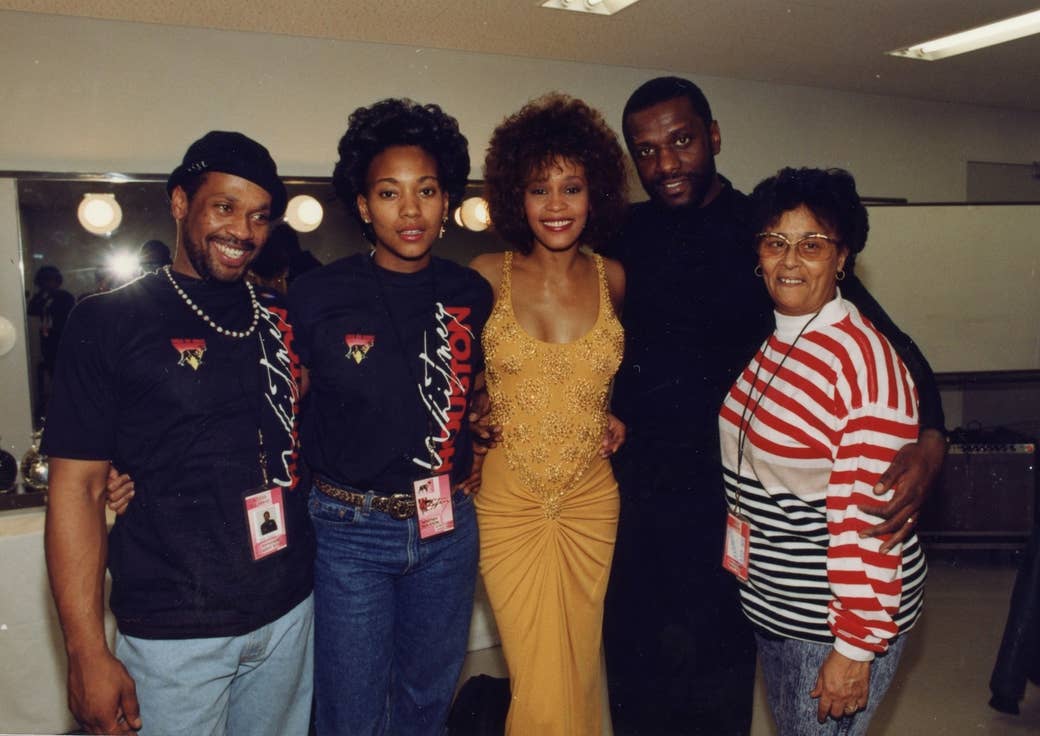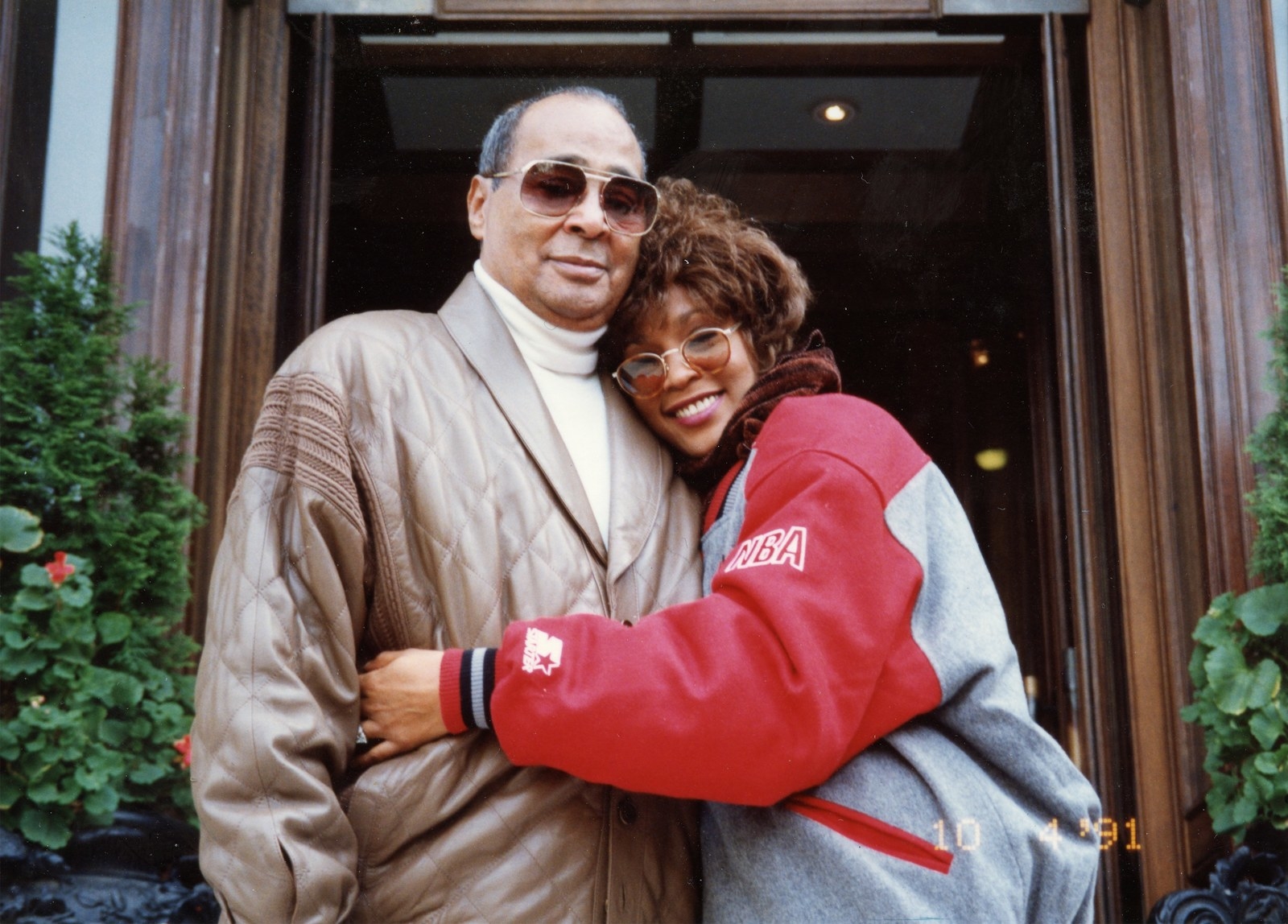
“The devil is trying to get me,” says Whitney Houston, at the beginning of the new documentary Whitney, recounting a haunting dream as images of her magical first hit play onscreen. “He never gets me, but when I wake up, I’m always exhausted from running.” This surreal image of a besieged Houston is meant to hint at the demons that haunted her before her tragic death in 2012, and which are once again being explored in this film, directed by Kevin Macdonald and opening in theaters July 6.
Houston’s brand of glossy pop made her a superstar, but it was the juxtaposition of that early ’80s image with the ensuing period of her publicly visible struggles, throughout the late ’90s and aughts, that sealed her legend. The “prom queen of soul” era — with the glamorous MTV videos and perfect pop hits — appeared so radically opposed to the Houston persona from the “crack is wack” years, that the public was left reeling, trying to find a narrative that might explain how these two sides fit together.
Narratives that look for personal and family demons to explain a pop star’s downfall have become de rigueur, from the ongoing speculation about the role of Britney Spears’ father in her conservatorship to the portrayal of Amy Winehouse’s family patriarch in 2015’s portrait, Amy. Because of their volatile, drug-fueled marriage, Houston’s former husband Bobby Brown became the first symbolic fall guy for her demise. Then, after her mother, Cissy Houston, told Oprah Winfrey in an interview that she would not have accepted a gay daughter, the specter of Houston’s sexual identity and her onetime lover Robyn Crawford became part of the narrative, and the role of Houston’s family in her life came under public scrutiny.
Last year’s unauthorized portrait, Whitney: Can I Be Me, broke new ground because it finally directly explored the issues that had percolated around Houston’s celebrity, but that she herself had rarely addressed. That film argued against the idea that her marriage to Brown caused her downfall, focusing instead — as the title hints — on the burden of her demure, respectable crossover pop image, her bisexuality and relationship with Crawford, and her fraught bond with her family, who grew to depend on her financially. Her estate attempted to stop the release of Can I Be Me, probably, in part, because her family members were portrayed as self-interested enablers, with their own stakes in keeping Whitney, Inc. going, almost disregarding her struggles with addiction.
This new documentary, which purports to offer a more intimate portrait of Houston, actually paints a more complex portrait of her family, adding new hues to our understanding of the singer’s life and career even as her own voice remains mostly absent. Whitney follows the same conflicts laid out in the previous film — from the creation of her crossover image to the Crawford rumors — but through the perspective of friends and family members, particularly her brothers, Michael and Gary, who are now willing to be publicly introspective in a way that Houston never really was.
Even before its release, Whitney made headlines because of the revelation that Houston was allegedly sexually abused as a child by her older cousin, Dee Dee Warwick. In the film, this disclosure is framed as one of the many demons that haunted her; her brother Michael says at one point that they were a tight-knit family, but full of secrets, “and if you don’t confront them, they never go away.” He and Gary appear relieved to be able to give up their image as, as one family friend puts it, “the Cosbys of Dodd Street.” And Whitney offers a fresh angle on Houston’s life by suggesting that her family, through their ambitions and their unspoken conflicts, both aided her rise and ultimately contributed to her downfall.

The idea that Arista Records head Clive Davis created the Whitney Houston we came to know is described in Whitney as an “urban legend.” Michael explains that it was their mother, Cissy, who, following her own failed attempt to cross over from gospel to mainstream stardom, “poured a lot of that disappointment into Whitney.” It was also their parents who set up record company showcases for her, and they understood, as one friend puts it, how to navigate a white-dominated world and live with the double consciousness required of black Americans. (The evocation of double consciousness is one of the few times that the nuances of racial identity are explicitly named in the documentary.)
Before her fame, Houston “liked to sleep, party, hang out with Robyn and her cat Misty Blue,” says her first manager, Steve Gittelman. Houston’s iconic role as the “black princess” of pop required denying her relationship with Crawford, but also hiding basic facts about the family. “People didn’t even know that John and Cissy were separated,” says former Arista publicist Lynne Volkman, because “family perfection” was an important part of what was being sold. Houston’s drug use, for years blamed on Bobby Brown, actually began with her brothers when she was 17. “If anything was gonna be done, I would be the one to show her,” says her brother, Michael.
The portraits of Houston’s parents are finally more fleshed out here, particularly of her father, John Houston, who died before she did and had played a smaller role in the narratives about her life than Cissy. He is portrayed as a troublingly controlling, opportunistic man. Initially a civil servant in a corrupt Newark, New Jersey, administration (“you do the math,” says one of the brothers about the nature of his father’s deal-making), he wiretapped his wife’s phone despite his own infidelities, and, after Houston rose to fame, even considered attempting to remove Crawford from her orbit by hiring goons to scare her off. (“We refrained from that because we didn’t know what the outcome could be,” says brother Gary, matter-of-factly.)

As soon as her career was established, Houston’s family members became her employees, and the lines between their personal and professional relationships blurred. Her father became a kind of de facto manager, basking in his sudden power thanks to his daughter’s success — he would request that people literally kiss his ring. Her brother Gary became a backup singer and Michael her tour road manager, remaining on the payroll even when they weren’t working for her. Her relationship with Crawford was a kind of “safety net, separate from the public or her parents,” her friend Ellin LaVar says.
Brown was, her brothers point out, the kind of guy her mother warned her against, which added to his appeal. Her assistant, Mary Jones, suggests that the early sexual abuse had confused Houston, and fueled her desire to seek the seeming normalcy of a marriage and motherhood. But during the massive success of The Bodyguard era, her relationship with Brown became troubled because he “knew he would never get there,” says friend and producer Debra Martin Chase, “and he shut down.” Because of Houston’s addiction, and what is depicted as a codependent relationship with Brown, their daughter, Bobbi Kristina, got lost in the shuffle and attempted to kill herself, years before her mother’s death.
All these family struggles are depicted as overwhelming Houston. Crawford, portrayed by all those interviewed as the one person willing to put Houston’s interests ahead of the moneymaking machine, left the family orbit after Houston asked for her resignation when Crawford gave Houston an ultimatum to choose between her and Brown. Houston ultimately realized that her father — who completely took over in Crawford’s absence — had been stealing from her, and she cut him off and didn’t attend his funeral. Her mother was scared to confront her about the drugs, and in turn, Houston never confided in her mother about her sexual abuse, fearful of her mother’s reaction. Houston’s final tour — full of boos and walkouts after she had lost her voice — and the movie Sparkle are shown to be financially motivated decisions based on the fact that she had run out of money, in large part because of her largesse and generosity to her family and friends.

It is not an accident that almost every narrative about Houston — including this one — emphasizes the imagery and shiny innocence of the early pop princess years, of songs and music videos like “How Will I Know” and “I Wanna Dance With Somebody,” as a way of playing up the stark contrast to the dark tragedy of her demise. But few take an interest in Houston’s later work, like the 1998 album My Love Is Your Love, in which she replaced the hyperfeminine gowns with pantsuits and melded her pop melodies with hip-hop soul, yielding anthems like “It’s Not Right but It’s Okay,” and “Heartbreak Hotel.” Those are the songs that suggested she did eventually find a different, more adult, style to represent herself.
But there is little sense of that Houston in this portrait. Like most of these documentaries, the nearly exclusive focus on Houston’s personal life leaves little room for insight into her music or work. And like the disembodied voice that opens and closes the film, Houston’s own presence and perspective are in many ways dreamlike, if not absent. “I think she was trying to find herself,” says Jones. Lost amid the context of the family drama and the expectations constantly swirling around her, it is hard to make out her own dreams or desires. Perhaps that was also how she felt, adrift in a hall of mirrors. Perhaps that is also why we’re still trying to find her. ●
Everything You Need To Know About "Whitney"
buzzfeed.com
BuzzFeed News talked to director Kevin Macdonald about what a difficult subject Whitney Houston was, her mercurial personal life, and how he unraveled the mystery of her previously unreported sexual abuse.
